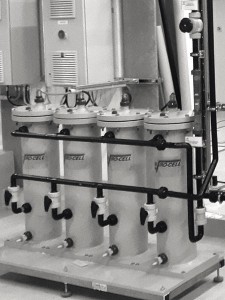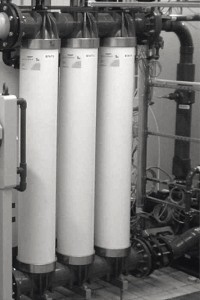Sustainability is a term that is commonly used to describe the replacement of plastic shopping bags with cloth and paper bags in supermarkets. But there is much more to it.
Introduction
 Fig. 1: Reactor for the catalytic decomposition of H2O2 in water Sustainability means reconciling the fulfillment of humanity's current and future needs with the limited capabilities of nature. To this end, the UN General Assembly adopted the "2030 Agenda for Sustainable Development" at the UN Sustainable Development Summit in 2015 with the aim of improving the quality of life on the planet within 15 years. To this end, 17 sustainability goals were defined, with point 6 being dedicated exclusively to drinking water as a resource.
Fig. 1: Reactor for the catalytic decomposition of H2O2 in water Sustainability means reconciling the fulfillment of humanity's current and future needs with the limited capabilities of nature. To this end, the UN General Assembly adopted the "2030 Agenda for Sustainable Development" at the UN Sustainable Development Summit in 2015 with the aim of improving the quality of life on the planet within 15 years. To this end, 17 sustainability goals were defined, with point 6 being dedicated exclusively to drinking water as a resource.
Against the backdrop of this agenda, the laws and regulations of individual countries regarding industrial drinking water consumption are likely to be tightened in the future. In addition, due to climatic changes, the consumption of drinking water as process water by industrial companies is also attracting increasing attention in our latitudes and will no longer be possible indefinitely in the future.
The situation was further exacerbated at the end of this year's heatwave when water shortages were identified across the board and politicians voiced the need for a quota system for the first time. This means that the unlimited supply of process water is no longer guaranteed in the event of a water shortage.
The situation in electroplating
Electroplating, with its consumption of large quantities of drinking water for the purpose of rinsing products after the etching process, is increasingly becoming the focus of sustainability considerations in the form of drinking water savings.
One way of doing this is to treat and recirculate rinsing water during PCB production, a process offered by enViro-cell GmbH in Oberursel, Germany, which is already being used successfully in operations.
The treatment of the rinsing water from the cascade for recirculation after the acid bath takes place in a 3-stage process of selective catalytic decomposition of the H2O2, electrochemical separation of the copper and subsequent particle cleaning with ultrafiltration.
Catalytic decomposition of hydrogen peroxide
 Fig. 2: Electrolysis The removal of H2O2 (hydrogen peroxide) from the rinsing water is necessary to enable the final step, the electrochemical separation of the copper from the water.
Fig. 2: Electrolysis The removal of H2O2 (hydrogen peroxide) from the rinsing water is necessary to enable the final step, the electrochemical separation of the copper from the water.
This is done by catalytic decomposition of the H2O2 according to the chemical formula
2 H2O2 -> 2 H2O+ O2 +192.2 KJ
This means that the hydrogen peroxide decomposes into water and oxygen, which escapes from the rinsing liquid into the environment. There is no contamination of the rinsing liquid. The heat development and the correct pH value range must be observed.
In the electrolytic cell, the copper is electrochemically deposited at the cathode. Electrolytic deposition of the metal ions as metals can only take place when there is hardly any hydrogen peroxide left.
Electrolysis is divided into two sub-processes, the cathode and the anode reaction.
At the anode, electrodes are emitted by the anions and the ions are oxidized, e.g.
2 H2 O -> 2 H2 + O + 2 e- oxidation
while at the cathode, electrons are accepted by the cations and the ions are reduced, e.g.
Cu2+ + 2 e- -> Cu reduction
In this case, the copper is deposited as a metal at the cathode. It can then be used further.
Electrolysis is therefore a process in which oxidation and reduction take place separately. The H2O2 can also be destroyed by electrolysis at the cathode. This always takes place preferably before copper deposition. However, the H2O2 makes the electrolysis much greater than would be necessary for copper deposition. The combination of stages 1+2 prevents the system from expanding to an uneconomical size.
Ultrafiltration
 Fig. 3: UltrafiltrationInthe final stage, the rinsing water is cleaned of impurities by micro- or ultrafiltration inpreparationfor further treatment. The membranes used for this are based on plastic. The membrane combines capillaries in a single, extremely robust fiber and thus guarantees outstanding stability.
Fig. 3: UltrafiltrationInthe final stage, the rinsing water is cleaned of impurities by micro- or ultrafiltration inpreparationfor further treatment. The membranes used for this are based on plastic. The membrane combines capillaries in a single, extremely robust fiber and thus guarantees outstanding stability.
Electrolytic copper separation is an almost complete regeneration process for spent pickling solutions, in which both the copper and the sulphuric acid are recovered, resulting in almost no waste water.
The exhausted pickling solution is removed from the pickling bath or an equalizing tank using a pump and fed to a storage tank. The acid that is not required runs back from there to the pickling plant. A partial stream runs into the electrolysis cells, where a large part of the copper carried along is deposited on the cathodes and the low-copper solution is returned to the pickling plant. During metal detoxification or recovery, the metals are deposited at the cathode in the electrolysis cell and thus recovered in metallic foil or powder form or on a fixed bed. By using an appropriate rinsing technique with simultaneous electrolytic copper separation, almost wastewater-free operation can be achieved.
THE AUTHORS
Dipl.-Ing. Wolfgang Dietz
Dipl.-Ing. Herbert Hager,


